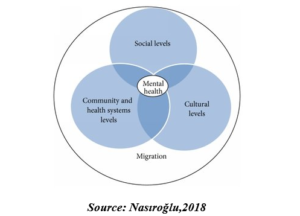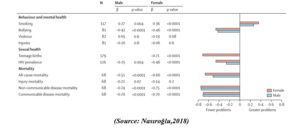Determinant of Mental Health Issues on teenage girls Assignment Sample
Here’s the best sample of Determinant of Mental Health Issues on teenage girls Assignment, written by the expert.
As one grows up, they adopt social and emotional behaviours that are good to their overall mental health. Adolescence is a key period in one’s life since it is a time when one’s mental well-being is most at risk. Adolescence is a phase of transition from childhood to adulthood that lasts from 12 to 18 years (Lund,2018). Individuals should learn effective coping and problem-solving techniques, as well as interpersonal skills, in addition to learning how to manage their emotions. This goes beyond simply having healthy sleep and exercise routines. It is vital for children and adolescents to grow up in circumstances that are protective and supportive, which can include environments at home, at school, and in the greater community, to name a few examples of such contexts (Roy,2019).
Discussion
Mental health issues in teenage girls
When it comes to one’s mental health and well-being, a wide variety of things might play a role. According to the findings of the study, the greater the number of risk factors that teenagers are exposed to, the greater the likelihood that these variables will have a negative impact on their mental health as a result of their exposure. Anxiety can be caused by a multitude of circumstances during adolescence, including trauma, peer pressure to conform, and the process of establishing one’s own sense of self. If the media and gender norms have an impact on adolescent views and objectives (O’Neil,2018), it is possible that this may increase the developing mismatch between their actual reality and their notions or dreams about the future. Some other essential elements to examine include the quality of their family life and the quality of their connections with their peers, both of which are incredibly crucial in terms of academic success (George,2020). Various incidents such as assault (especially sexual violence and bullying), harsh parenting, severe and chronic socioeconomic obstacles, and other occurrences are all recognised as being detrimental to one’s emotional well-being on a psychological level (George2020).

National Center for Health Statistics reports that the prevalence of behavioural disorders among younger adolescents in the United States is higher than that of behavioural disorders among older adolescents in the country, according to the National Center for Health Statistics.(Keyes,2018).
Determinants influencing/ Affecting the mental health of teenage girls
A number of potentially detrimental risk-taking behaviours for one’s health, such as substance misuse and sexual risk-taking, begin to emerge around this period. For example, Adolescents’ risk-taking behaviours can be inefficient coping mechanisms when presented with emotional challenges, and they can have a negative impact on their mental and physical well-being as a result.
Addiction
During the year 2016, a total of 13.6 percent of cases worldwide were teens aged 15 to 19 years who were found to be excessively drinking on an episodic basis, with boys being the ones who were most at risk of developing an alcohol addiction.
Smoking and cannabis consumption are two other problems to take into consideration.. According to the findings of a recent study, a high majority of adult smokers began smoking their first cigarette before the age of eighteen. Cannabis use among 15-16-year-olds outpaces that of any other illicit drug, with roughly 4.7 percent of those between the ages of 15 and 16 reporting having used it at least once throughout the course of 2018.
Risk Taking Behaviours
Involvement in violence is a high-risk behaviour that raises the possibility of poor academic achievement in the future, as well as bodily harm, involvement in criminal activity, and, in the worst circumstances, death, among other negative outcomes. According to the Centers for Disease Control and Prevention, interpersonal violence was one of the leading causes of death among older teenage girls in 2019.
Critical Discussion
The fact that these teenage girls are more vulnerable to developing mental health problems than other teenagers can be attributed to a variety of factors including their living arrangements, their experiences of stigma and prejudice, as well as a lack of access to high-quality support and resources, among other factors. Children and adolescents living in humanitarian and fragile environments, adolescents suffering from chronic illnesses such as autism spectrum disorder or intellectual disability, adolescents who are pregnant or who are married early or forcedly, orphans, and youth from minority ethnic or sexual backgrounds or from other discriminated groups are among those who fall into this category (McQuaid,2021).

Because of the way their brains are developing, adolescents are particularly vulnerable to emotional disorders. When it comes to teens in this age group, anxiety disorders (which include panic attacks and excessive worrying) are by far the most frequent, with older teenagers suffering from these disorders at a higher rate than their younger friends. As predicted by the prevalence rates, anxiety disorders will affect 3.6 percent of children aged 10-14 and 4.6 percent of teenagers between the ages of 15 and 19. An estimated 1.1 percent of teenagers aged 10-14 years and a 2.8 percent of adolescents aged 15-19 years are afflicted by depression, according to the American Psychological Association. According to the research, females account for the vast majority of depression cases diagnosed. Depression and anxiety symptoms are similar in that they both involve rapid and unexpected changes in mood and behaviour, as well as changes in food and sleeping patterns (Nasıroğlu,2018).
Anxiety and depressive disorders, which are widespread among college students, can have a substantial impact on a student’s ability to attend school and perform well academically. It is possible that withdrawing one’s presence from social situations will exacerbate one’s feelings of loneliness and alienation.
Conclusion
It should be the goal of psychosocial interventions to improve an individual’s ability to regulate emotions, increase the availability of alternatives to risk-taking behaviours, increase resilience in the face of adversity and difficult situations, and foster supportive environments and social networks in order to promote and prevent mental illness.
References
George, A. S., Amin, A., de Abreu Lopes, C. M., & Ravindran, T. S. (2020). Structural determinants of gender inequality: why they matter for adolescent girls’ sexual and reproductive health. bmj, 368. https://www.bmj.com/content/368/bmj.l6985.abstract
Keyes, K.M., Gary, D., O’Malley, P.M., Hamilton, A. and Schulenberg, J., 2019. Recent increases in depressive symptoms among US adolescents: trends from 1991 to 2018. Social psychiatry and psychiatric epidemiology, 54(8), pp.987-996. https://www.sciencedirect.com/science/article/pii/S0165178120333096
Lund, C., Brooke-Sumner, C., Baingana, F., Baron, E. C., Breuer, E., Chandra, P., … & Saxena, S. (2018). Social determinants of mental disorders and the Sustainable Development Goals: a systematic review of reviews. The Lancet Psychiatry, 5(4), 357-369. https://www.sciencedirect.com/science/article/pii/S2215036618300609
McQuaid, R. J., Cox, S. M., Ogunlana, A., & Jaworska, N. (2021). The burden of loneliness: Implications of the social determinants of health during COVID-19. Psychiatry Research, 296, 113648. https://www.sciencedirect.com/science/article/pii/S0165178120333096
Nasıroğlu, S., Çeri, V., Erkorkmaz, Ü., & Semerci, B. (2018). Determinants of psychiatric disorders in children refugees in Turkey’s Yazidi refugee camp. Psychiatry and Clinical Psychopharmacology, 28(3), 291-299. https://www.tandfonline.com/doi/abs/10.1080/24750573.2017.1422958
O’Neil, A., Scovelle, A. J., Milner, A. J., & Kavanagh, A. (2018). Gender/sex as a social determinant of cardiovascular risk. Circulation, 137(8), 854-864. https://www.ahajournals.org/doi/abs/10.1161/circulationaha.117.028595
Roy, K., Shinde, S., Sarkar, B. K., Malik, K., Parikh, R., & Patel, V. (2019). India’s response to adolescent mental health: a policy review and stakeholder analysis. Social psychiatry and psychiatric epidemiology, 54(4), 405-414. https://link.springer.com/article/10.1007/s00127-018-1647-2
________________________________________________________________________________
Know more about UniqueSubmission’s other writing services:

